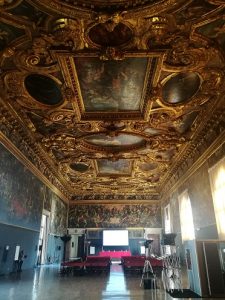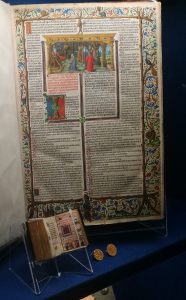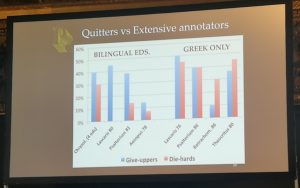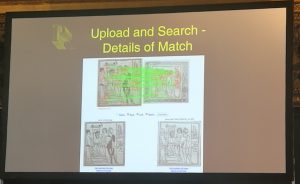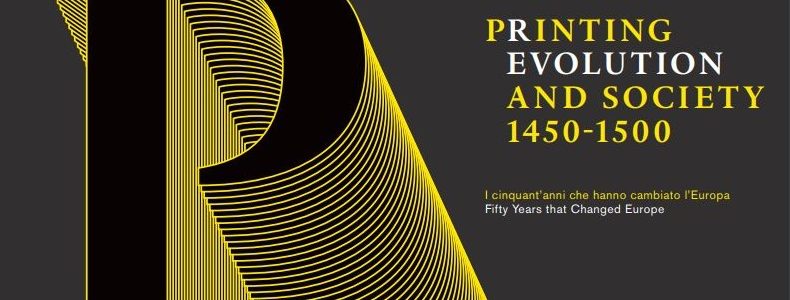
Printing R-Evolution and Society 1450-1500: a conference reflection
Venice showed itself at its most beautiful in late September when hosting a gathering of over 100 academics, librarians, members of the book trade and other interested researchers at the Palazzo Ducale, there to discuss the first 50 years of trade in the printed book at the conference Printing R-Evolution and Society 1450-1500: Fifty years that changed Europe. The very concept of a revolution was up for discussion, as delegates and speakers heard 34 papers on all conceivable aspects of the production and trade of printed materials across Europe. The event was one of the major outputs of the 5-year European Research Council-funded 15th Century Booktrade project, led by Professor Cristina Dondi. This innovative research project brings together historians and linguists alongside librarians and computer scientists to imagine new ways of working with and interpreting the very varied records relating to books in the first half-century of print in Europe, primarily through the database Material Evidence in Incunabula (MEI). Evidence abounds in different forms and formats about the production and movement of books in many countries, and the aim of this project is to bring that evidence together and provide ways to manipulate, visualise and exploit it in ways that were not possible only a few decades ago.
The conference was based in Venice as one of the primary centres of the European book trade; between 1469 and 1500 some 200 named printers produced nearly 3,800 recorded editions, over 10% of the approximately 28,000 identified in the Incunabula Short Title Catalogue. This gave delegates a sense of being right at the heart of the activity being discussed; the conference room itself was the Sala dello Scrutineo of the Palazzo Ducale, which in its early years was known as the Library. Its balcony opens out onto the Biblioteca Marciana, whose collections were discussed extensively across all three days as well as forming the heart, alongside the collections of the Museo Correr, of the stunning exhibition bringing the project into the public eye. There could have been no better place for the conference.
The papers fell into three main subject areas: the records for the book trade and what they can tell us about audiences and consumers of books; detailed case studies of particular collections of incunabula and book producers; and the uses of new technologies, particularly web-based databases, to gain a new understanding of these books. At a personal level I found the final discussions the most exciting and thought-provoking, and they sent me home full of ideas about the possibilities for exploiting the University Library’s 4,600 incunabula as part of a wider network of scholarship. The full programme for the conference remains available online, and in this post I focus on the papers which I found the most inspirational.
Visitors to the Library nearly always ask how much early books actually cost their buyers, and it is always difficult to give a realistic answer. Even if an owner has helpfully written the price they paid onto a title page, what was a pound, or a franc, or a lira, actually worth to them? The papers presented by Isabella Cecchini, Paola Pinelli and Cristina Dondi provided concrete evidence of the incomes and expenditures of Tuscan and Venetian workers at different levels of society, making it possible to establish how much of their regular income individuals were willing to assign to books. Paola Pinelli’s discussion of the records of labourers working at the Ospedale della Misericordia in Prato Prato, Tuscany, summed up the spare money available to the majority of the population. For a labourer, some 70% of daily income would be spent on the essentials, primarily wheat and wine. Paola noted that wages did fluctuate considerably according to the number of building projects at any given time. Costs of books recorded in an account book for 1463-77 in the Tuscan archives give a wide range of prices, which in comparison to wages gave the cost of a cheap book as equivalent to anywhere from 1 month to 1 year’s expenditure on wine, or the total average cost of living for 12 days. A more luxurious book could be the equivalent of 6 months’ daily expenses for a labourer.
Cristina Dondi spoke on the evidence provided by the Zornale of Francesco de Madiis, an immense account book listing some 7000 sales amounting to 25,000 individual books in Venice between 1484 and 1488; the study of this volume was the spark which led to the creation of the 15th Century Booktrade project. Bearing in mind that printing had only been in Venice for 15 years when this record began, the evidence of the Zornale shows conclusively that books had already become accessible to many in contemporary society. Some 1160 sales in the Zornale were at a sum less than the daily wage of a builder (averaging 15 soldi). The cheapest, and also best-selling, book, was the Psalterium puerorum printed by Erhardt Ratdolt, a 16-page grammar to teach children to read. Only one copy survives, yet 659 copies are recorded in the Zornale at the cost of 4 soldi each; this was the price of a chicken, or a packet of sugar. The most expensive book listed was a Glossa ordinaria, comprising 1628 pages sold for 1240 soldi. This was the same price as ‘a very beautiful little manuscript book of hours’; the exhibition displayed the Marciana’s beautifully decorated copy of the Glossa alongside such a manuscript. More typical were the sales of literature and classics at 20-40 soldi, a day’s wage for a master builder, and well within reach of many members of late 15th-century Venetian society. Comparing this to the cost of books today is salutary; the UK living wage is currently £8.75 per hour, and the cost of the hardback book currently topping the Times Bestsellers chart is £14, or £8 through online aggregators. This is rather higher than the equivalent chicken or sugar, but certainly less than the daily wage.
This simple conclusion was immediately questioned by Neil Harris who spoke on the forgotten costs of a book, primarily rubrication and illumination. These are of course not essential and a printed book can be read without being decorated; nevertheless he emphasised that it would be disingenuous to look at an ornamented volume without considering the additional costs involved. Neil compared it to the Ryanair model; a set of printed sheets was the basic unit, but adding the elements which made it luxurious could up to double the price paid by the final purchaser. A rubricator’s totting-up in a volume in the Boston Public Library gave solid numbers: one gold initial, 175 letters, and 2035 paraph marks were priced on a blank sheet at the end of the volume. Other speakers on Italian sources around book prices were Sara Mansutti, Ester Peric (who spent a month at the UL this summer working on MEI), Lorenz Bonninger and Paolo Tinti, while Claire Bolton gave a comparison with Memmingen, Monique Hulvey with Lyon, and Antonio Iglesias Fonseca with Catalonia.
Papers looking at specific book types and producers covered a wide range of subjects. Sabrina Minuzzi discussed the production of books of materia medica, noting that only in Spain were more produced in vernacular languages than Latin, while in Italy only 10% were published in Italian. Many were also heavily annotated by later owners, both in Latin and vernaculars, calling to mind the UL’s copy of the Opus pandectarum with its many diagrams and notes by successive early owners, or 50 years later the English names added to illustrations in the Basel-printed Historia stirpium. Of the 55 editions of the Liber secretum de virtutibus herbarum that Sabrina studied, the great majority of ‘provenance blocks’ recorded in MEI occurred before 1550; these books appeared to be heavily used while they were still new, but superseded in practical use by later editions.
This is perhaps to be expected; it only becomes regrettable when earlier editions are disposed of and the newer ones alone retained. This practice of weeding is an essential aspect of library management, of course, but we might wish that our predecessors had known the future value of the early and historic editions they rejected in favour of the (then) modern. Geri della Rocca de Candal discussed the two types of annotators many librarians are familiar with in the context of Greek classical texts. Those studying the easier works frequently ‘gave up’ earlier, while those working on harder texts, perhaps within the context of a schoolroom, tended to carry on annotating further.
Eric White’s paper also looked at the useful lifespan of works, using as examples the Gutenberg Bible and the Ars Minor of Donatus, the latter text surviving only in fragments. His study looked at the dates from which these books were deconstructed and used to bind new volumes, giving an indication of when they had outlived their usefulness. He suggested that Gutenbergs generally lasted for around 150 years before they were deconstructed, while Donatus sheets were already being used in this way in the late 15th century, giving them barely 40 years of useful life. Eric appealed to all librarians and book collectors to leave any binding waste in situ, which we naturally all agreed with; if only earlier librarians and collectors had felt the same. This came to mind recently when I identified a leaf of Hall’s Paraphrase of the Old Testament, published 1633, in the binding of an edition of Donne’s poems also from 1633; both works were printed by Miles Flesher, and it is interesting to question how they came to be together in the bound volume.
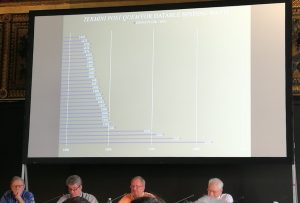
Eric White’s illustration of the dates of books in whose bindings fragments of Donatus are found, within 40 years of its publication.
Falk Eisermann’s paper title “Did you mean incurable? Searching and finding incunabula in the world wide web” brought a laugh of recognition. He looked at the numerous ways in which incunabula are being brought to light through social media, and the work the team at the Gesamtkatalog der Wiegendrucke is doing to gather this information into the more formalised databases. Smaller libraries and museums are using the well-established tools of Twitter and Instagram to publicise their collections, and smaller scale digitisation projects are locating previously unknown editions, but these are not necessarily being reported to the major union catalogues, leaving them out of some of the projects under discussion. This was food for thought alongside John Lancaster’s discussion of his work adding American libraries’ holdings to MEI. At present there are some 53,000 incunabula recorded in US libraries, around 10% of the total recorded in GW, but less than 0.5% are currently described in MEI. 60% of these are held in just 15 libraries, and projects to upgrade their records would be immensely valuable. While MEI is potentially a great resource, work being done using its content must come with a caveat that it is by no means comprehensive; attempts to come up with far-reaching conclusions around the use of books can only be provisional and some of the conference papers did not make this explicit.
Among the most inspiring papers were those looking at new exploitation of the information held within ISTC; Alex Jahnke (described by Claudia Fabian as a “metadata sculptor”) discussed the many separate databases he has helped create, including Owners of Incunabula, the CERL thesaurus, and MEI itself. Greg Prickman gave a preview of the updated interface to the Atlas of Early Printing which has long been a favourite for illustrating the spread of print in the fifteenth century; he did note that the visualisation was based only on the known information in ISTC and that we cannot know about the books not listed in that database, but are reliant on the uploaded data. The possibility of discovering more about reuse of images becomes a reality with the 15th century illustration project, explained by Abishek Dutta and Matilde Malaspina and based on software created for the Oxford Broadside Ballads project. Using multi-lingual Iconclass tagging enables users to search by specific image, or to upload their own files and use the algorithm to match to those already within the database. The Cambridge Digital Humanities Lab is working with scholars to do similarly innovative work based on digital evidence, and I am looking forward to seeing what new ideas can be born around our incunabula collections.
Databases like this will become increasingly useful as more institutions upload their data and information, and are very reliant on the background work being done by librarians and researchers. Marieke van Delft explained the collaborative work of the CERL provenance digital archive; thousands of images are uploaded from online resources to share provenances in the form of bookplates, annotations, bindings, and stamps. The intention is to continue the excellent work of the CERL provenance ‘Can you help?’ service, in which those of us with as-yet-unidentified owners share images in the hope that bookplates, rebuses and scrawled signatures might be familiar to others.
The overwhelming conclusion of the conference as a whole is that incunabula studies are flourishing at both the macro and micro levels. Whether one is interested in tracing exactly which books were illuminated by a given artist in a given city, or looking at wider patterns of where books moved and when, the evidence is available and it is up to us as librarians to make it available to scholars in whatever ways we can. The University Library’s incunabula cataloguing project, led by William Hale and Laura Nuvoloni, made our own holdings fully discoverable for the first time, and brought to light thousands of instances of use by early owners, which we are currently making fully searchable through MEI. The databases under discussion are reliant on the efforts of individual libraries, however, in describing their own holdings and sharing information about them. While I would recommend a degree of caution in making overly grand conclusions from the current forms of these databases – what will come to light when all those American incunabula are described in MEI, and how might this change our understanding? – Kristian Jensen equally suggested that if we wait until all the information is available, we might never start answering our own questions. It’s thanks to the diligent work of past generations of scholars that we have the resources to do this, and it’s a privilege to be part of the growing network of collaboration that is bringing more information into the public arena.

